Aedes aegypti
and Dengue fever
by Roland Mortimer, Rio de Janeiro
There are many types of mosquito living in the tropical and sub-tropical regions of the world, we can roughly
them divide into two groups, CULEX and AEDES, but perhaps one of the most important is Aedes aegypti.
According to the World Health Organisation, the virus for Dengue fever is the most important arbovirus to man in
the world, and since Aedes has been found to transmit this virus, it has been widely studied and blamed
as the vector.
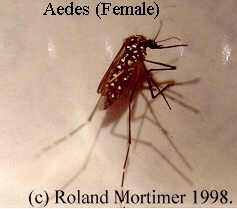 This mosquito
is small in comparison to others, usually between three to four millimetres in length discounting leg length. It
is totally black apart from white 'spots' on the body and head regions and white rings on the legs. The thorax
is decorated with a white 'Lyre' shape of which the 'chords' are two dull yellow lines. Its wings are translucent
and bordered with scales. At rest, the insect turns up its hind legs in a curved fashion and usually cleans them
by rubbing one against the other, or exercises them by crossing them and alternately raising and lowering them,
this may even be a way of helping digested 'food' along the alimentary canal, but this is just a guess on my part.
This mosquito
is small in comparison to others, usually between three to four millimetres in length discounting leg length. It
is totally black apart from white 'spots' on the body and head regions and white rings on the legs. The thorax
is decorated with a white 'Lyre' shape of which the 'chords' are two dull yellow lines. Its wings are translucent
and bordered with scales. At rest, the insect turns up its hind legs in a curved fashion and usually cleans them
by rubbing one against the other, or exercises them by crossing them and alternately raising and lowering them,
this may even be a way of helping digested 'food' along the alimentary canal, but this is just a guess on my part.
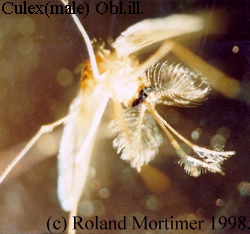 Many
people believe mosquitoes only live two or three days, but in actual fact, left unmolested they can live for months.
The males of all species of mosquitoes do not bite humans or animals of any species, they live on fruit. Only the
female bites for blood which she needs to mature her eggs. The eggs of most species are laid together in a raft
form, but Aedes lays her eggs separately thus allowing them to spread over large surfaces of water if
conditions permit, this way the eggs stand a better chance of survival.
Many
people believe mosquitoes only live two or three days, but in actual fact, left unmolested they can live for months.
The males of all species of mosquitoes do not bite humans or animals of any species, they live on fruit. Only the
female bites for blood which she needs to mature her eggs. The eggs of most species are laid together in a raft
form, but Aedes lays her eggs separately thus allowing them to spread over large surfaces of water if
conditions permit, this way the eggs stand a better chance of survival.
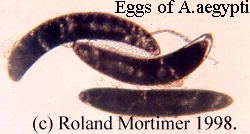 When
freshly laid the eggs are white but soon turn black in colour. The young larvae feed on bacteria in the water and
soon cast their skins as they rapidly grow. Here, I must point out the fact that most species lay their eggs in
any type of water, mainly dirty or even polluted. Not Aedes, she only lays her eggs in clean water which
contains no other living species. I began studying this insect in January this year simply because I caught the
virus she carries as a vector twice. The second infection gave me what is known as hemorrhagic Dengue.
When
freshly laid the eggs are white but soon turn black in colour. The young larvae feed on bacteria in the water and
soon cast their skins as they rapidly grow. Here, I must point out the fact that most species lay their eggs in
any type of water, mainly dirty or even polluted. Not Aedes, she only lays her eggs in clean water which
contains no other living species. I began studying this insect in January this year simply because I caught the
virus she carries as a vector twice. The second infection gave me what is known as hemorrhagic Dengue.
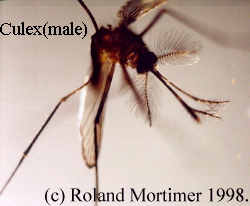 Many
people have died from this fever and many more around the world suffer terribly because of it. Even though this
small creature is responsible for so much suffering and death around the world (it is also the vector for Yellow
Fever) I cannot help admiring the intelligence and beauty of the insect after studying it so closely. Here, I'd
prefer to refer to it as 'her' because we are really talking about the female of the species and only her. The
male mosquito is much more beautiful, his antennae looking like large plumes and the palpi long and adorned with
feathery hairs. After a few weeks or even shorter in the summer, the larvae reach the pupa stage, this stage is
usually very short and the pupae rise to the surface of the water where the top of the pupal case opens like the
lid on a can and out emerges the new adult.
Many
people have died from this fever and many more around the world suffer terribly because of it. Even though this
small creature is responsible for so much suffering and death around the world (it is also the vector for Yellow
Fever) I cannot help admiring the intelligence and beauty of the insect after studying it so closely. Here, I'd
prefer to refer to it as 'her' because we are really talking about the female of the species and only her. The
male mosquito is much more beautiful, his antennae looking like large plumes and the palpi long and adorned with
feathery hairs. After a few weeks or even shorter in the summer, the larvae reach the pupa stage, this stage is
usually very short and the pupae rise to the surface of the water where the top of the pupal case opens like the
lid on a can and out emerges the new adult.
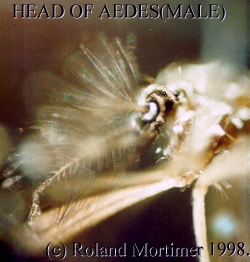 Aedes
aegypti, unlike other species is very intelligent, if one could say that mosquitoes are intelligent. They
arrived in Brazil from Ethiopia with the slave trading ships. Living near man for so long she has become totally
dependant on him and has learned a lot from him. For instance, she has greatly reduced the `humming' sound she
makes with her wings so man cannot hear it, unlike other species whose humming is extremely irritating and awakens
the deepest sleeper. She never lives more than ninety meters from dwellings thus guaranteeing her meals. She attacks
from below or behind, usually from underneath desks or chairs and mainly at the feet and ankles. The insect is
very fast in flight unless gorged with blood. Other types of mosquito even fly into your face and can be easily
caught or killed, not Aedes, she's too smart.
Aedes
aegypti, unlike other species is very intelligent, if one could say that mosquitoes are intelligent. They
arrived in Brazil from Ethiopia with the slave trading ships. Living near man for so long she has become totally
dependant on him and has learned a lot from him. For instance, she has greatly reduced the `humming' sound she
makes with her wings so man cannot hear it, unlike other species whose humming is extremely irritating and awakens
the deepest sleeper. She never lives more than ninety meters from dwellings thus guaranteeing her meals. She attacks
from below or behind, usually from underneath desks or chairs and mainly at the feet and ankles. The insect is
very fast in flight unless gorged with blood. Other types of mosquito even fly into your face and can be easily
caught or killed, not Aedes, she's too smart.
The eggs can survive for very long periods in a dry state, often for more than a year. Since the virus can be
passed from adult to egg then the virus too is guaranteed survival until the next summer and heavy rains. The virus
remains in the salivary glands of the mosquito, and when she bites for food, she injects saliva into the wound
where the anti-coagulants contained in her saliva facilitate feeding, without knowing it, she also injects the
virus into the host.
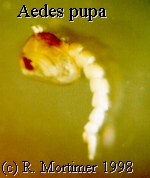
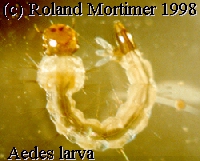 There are no
intermediate animal vectors for the virus, it seems the system is contained in man/mosquito/man relationships.
Aedes is very domesticated, as much as your pet dog or cat, most mosquitoes can live in forested areas
a long way from humans and live on animal blood, not Aedes, she relies on man and will only bite animals
in his total absence, although the female does actually take juices from various types of fruit at times. The water
here in Brazil is very well chlorinated, but, even so, Aedes does well in this same chlorinated water.
There are no
intermediate animal vectors for the virus, it seems the system is contained in man/mosquito/man relationships.
Aedes is very domesticated, as much as your pet dog or cat, most mosquitoes can live in forested areas
a long way from humans and live on animal blood, not Aedes, she relies on man and will only bite animals
in his total absence, although the female does actually take juices from various types of fruit at times. The water
here in Brazil is very well chlorinated, but, even so, Aedes does well in this same chlorinated water.
Another species of Aedes, Aedes albopictus is known to transmit Yellow fever, the chances
are she is also capable of transmitting Dengue fever too. There is a vaccination available for Yellow fever but
up till now there is no form of treatment against Dengue fever. There are actually four virus types. The first
infection is `mild' in comparison to the second and following infections, this is referred to as 'Classical Dengue
Fever,' very high fever (40C) and heavy flu'- type symptoms with extreme pains in the joints and eye orbits. The
second infection can and usually results in hemorrhagic Dengue, where bleeding occurs from the eyes, nose and other
more remote parts of the body.
At the moment of writing, Rio de Janeiro is in an epidemic state of Dengue fever and there have been two cases
of hemorrhagic dengue reported. According to the Health Minister the epidemic is now out of control and it is estimated
that six people are infected with the virus every hour, about a thousand new victims per week.
Comments to the author Roland Mortimer welcomed.
© Microscopy UK or their contributors.
Please report any Web problems to the Micscape Editor.
Micscape is the on-line monthly magazine of the Microscopy UK Web site at http://www.microscopy-uk.net
© Onview.net Ltd, Microscopy-UK, and all contributors 1995 onwards. All rights
reserved. Main site is at www.microscopy-uk.org.uk with full mirror at www.microscopy-uk.net.
 This mosquito
is small in comparison to others, usually between three to four millimetres in length discounting leg length. It
is totally black apart from white 'spots' on the body and head regions and white rings on the legs. The thorax
is decorated with a white 'Lyre' shape of which the 'chords' are two dull yellow lines. Its wings are translucent
and bordered with scales. At rest, the insect turns up its hind legs in a curved fashion and usually cleans them
by rubbing one against the other, or exercises them by crossing them and alternately raising and lowering them,
this may even be a way of helping digested 'food' along the alimentary canal, but this is just a guess on my part.
This mosquito
is small in comparison to others, usually between three to four millimetres in length discounting leg length. It
is totally black apart from white 'spots' on the body and head regions and white rings on the legs. The thorax
is decorated with a white 'Lyre' shape of which the 'chords' are two dull yellow lines. Its wings are translucent
and bordered with scales. At rest, the insect turns up its hind legs in a curved fashion and usually cleans them
by rubbing one against the other, or exercises them by crossing them and alternately raising and lowering them,
this may even be a way of helping digested 'food' along the alimentary canal, but this is just a guess on my part. Many
people believe mosquitoes only live two or three days, but in actual fact, left unmolested they can live for months.
The males of all species of mosquitoes do not bite humans or animals of any species, they live on fruit. Only the
female bites for blood which she needs to mature her eggs. The eggs of most species are laid together in a raft
form, but Aedes lays her eggs separately thus allowing them to spread over large surfaces of water if
conditions permit, this way the eggs stand a better chance of survival.
Many
people believe mosquitoes only live two or three days, but in actual fact, left unmolested they can live for months.
The males of all species of mosquitoes do not bite humans or animals of any species, they live on fruit. Only the
female bites for blood which she needs to mature her eggs. The eggs of most species are laid together in a raft
form, but Aedes lays her eggs separately thus allowing them to spread over large surfaces of water if
conditions permit, this way the eggs stand a better chance of survival. When
freshly laid the eggs are white but soon turn black in colour. The young larvae feed on bacteria in the water and
soon cast their skins as they rapidly grow. Here, I must point out the fact that most species lay their eggs in
any type of water, mainly dirty or even polluted. Not Aedes, she only lays her eggs in clean water which
contains no other living species. I began studying this insect in January this year simply because I caught the
virus she carries as a vector twice. The second infection gave me what is known as hemorrhagic Dengue.
When
freshly laid the eggs are white but soon turn black in colour. The young larvae feed on bacteria in the water and
soon cast their skins as they rapidly grow. Here, I must point out the fact that most species lay their eggs in
any type of water, mainly dirty or even polluted. Not Aedes, she only lays her eggs in clean water which
contains no other living species. I began studying this insect in January this year simply because I caught the
virus she carries as a vector twice. The second infection gave me what is known as hemorrhagic Dengue. Many
people have died from this fever and many more around the world suffer terribly because of it. Even though this
small creature is responsible for so much suffering and death around the world (it is also the vector for Yellow
Fever) I cannot help admiring the intelligence and beauty of the insect after studying it so closely. Here, I'd
prefer to refer to it as 'her' because we are really talking about the female of the species and only her. The
male mosquito is much more beautiful, his antennae looking like large plumes and the palpi long and adorned with
feathery hairs. After a few weeks or even shorter in the summer, the larvae reach the pupa stage, this stage is
usually very short and the pupae rise to the surface of the water where the top of the pupal case opens like the
lid on a can and out emerges the new adult.
Many
people have died from this fever and many more around the world suffer terribly because of it. Even though this
small creature is responsible for so much suffering and death around the world (it is also the vector for Yellow
Fever) I cannot help admiring the intelligence and beauty of the insect after studying it so closely. Here, I'd
prefer to refer to it as 'her' because we are really talking about the female of the species and only her. The
male mosquito is much more beautiful, his antennae looking like large plumes and the palpi long and adorned with
feathery hairs. After a few weeks or even shorter in the summer, the larvae reach the pupa stage, this stage is
usually very short and the pupae rise to the surface of the water where the top of the pupal case opens like the
lid on a can and out emerges the new adult. Aedes
aegypti, unlike other species is very intelligent, if one could say that mosquitoes are intelligent. They
arrived in Brazil from Ethiopia with the slave trading ships. Living near man for so long she has become totally
dependant on him and has learned a lot from him. For instance, she has greatly reduced the `humming' sound she
makes with her wings so man cannot hear it, unlike other species whose humming is extremely irritating and awakens
the deepest sleeper. She never lives more than ninety meters from dwellings thus guaranteeing her meals. She attacks
from below or behind, usually from underneath desks or chairs and mainly at the feet and ankles. The insect is
very fast in flight unless gorged with blood. Other types of mosquito even fly into your face and can be easily
caught or killed, not Aedes, she's too smart.
Aedes
aegypti, unlike other species is very intelligent, if one could say that mosquitoes are intelligent. They
arrived in Brazil from Ethiopia with the slave trading ships. Living near man for so long she has become totally
dependant on him and has learned a lot from him. For instance, she has greatly reduced the `humming' sound she
makes with her wings so man cannot hear it, unlike other species whose humming is extremely irritating and awakens
the deepest sleeper. She never lives more than ninety meters from dwellings thus guaranteeing her meals. She attacks
from below or behind, usually from underneath desks or chairs and mainly at the feet and ankles. The insect is
very fast in flight unless gorged with blood. Other types of mosquito even fly into your face and can be easily
caught or killed, not Aedes, she's too smart.
 There are no
intermediate animal vectors for the virus, it seems the system is contained in man/mosquito/man relationships.
Aedes is very domesticated, as much as your pet dog or cat, most mosquitoes can live in forested areas
a long way from humans and live on animal blood, not Aedes, she relies on man and will only bite animals
in his total absence, although the female does actually take juices from various types of fruit at times. The water
here in Brazil is very well chlorinated, but, even so, Aedes does well in this same chlorinated water.
There are no
intermediate animal vectors for the virus, it seems the system is contained in man/mosquito/man relationships.
Aedes is very domesticated, as much as your pet dog or cat, most mosquitoes can live in forested areas
a long way from humans and live on animal blood, not Aedes, she relies on man and will only bite animals
in his total absence, although the female does actually take juices from various types of fruit at times. The water
here in Brazil is very well chlorinated, but, even so, Aedes does well in this same chlorinated water.